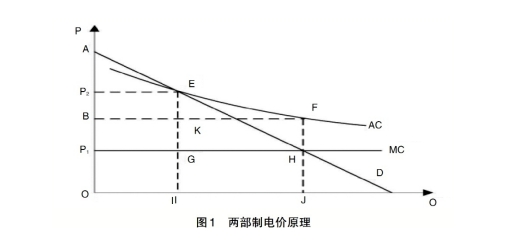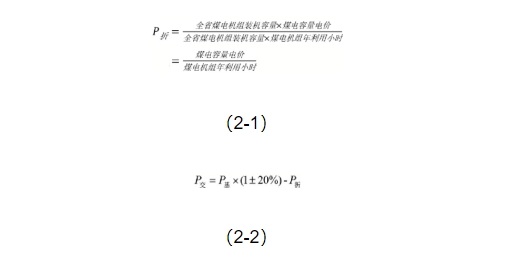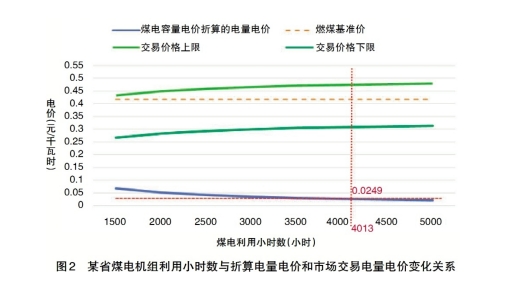The "Notice on Establishing a Coal-fired Power Capacity Tariff Mechanism" (Reform and Development Price [2023] No.1501, hereinafter referred to as "Document 1501") issued by the National Development and Reform Commission and the National Energy Administration stipulates that from January 1, 2024, coal-fired power units will implement the capacity tariff mechanism.As Document 1501 does not specify the exact method for forming the energy tariff level after the implementation of the coal-fired power capacity tariff mechanism, provinces generally convert the capacity tariff into an energy tariff and deduct it from the electricity price formed by the "base price + upward and downward fluctuation" mechanism. This serves as the method for forming the energy tariff level in market transactions.If the electricity price formed by the "base price + upward and downward fluctuation" mechanism is regarded as the average cost pricing result, the current practice essentially reverts the two-part tariff for coal-fired power back to a single energy tariff. Consequently, the policy objective of promoting the transformation and development of coal-fired power units through the coal-fired power capacity tariff mechanism is not guaranteed.
This phenomenon is related to the incomplete design of the coal-fired power capacity tariff mechanism.Document 1501 proposes a new coal-fired power tariff structure but does not clarify the formation mechanism of energy tariffs compatible with the tariff structure. Specifically, the relationship between Document 1501 and the 2021 "Notice of the National Development and Reform Commission on Further Deepening the Market-oriented Reform of Coal-fired Power Generation上网Tariff" (Reform and Development Price [2021] No.1439, hereinafter referred to as "Document 1439") regarding the "base price + upward and downward fluctuation" policy for coal-fired power units has not been clarified.On the basis of pointing out the shortcomings of the coal-fired power capacity tariff mechanism and adhering to the principle of implementing a two-part tariff for coal-fired power units, this article proposes improvements to the coal-fired power capacity tariff mechanism based on Document 1501.
Analysis of Coal-fired Power Two-part Tariff and Its Functions
The deviation in the implementation of the coal-fired power capacity tariff mechanism is related to Document 1501's inaccurate and insufficient grasp of the two-part tariff principle.
Principle and Analysis of Two-part Tariff
For commodities with a large proportion of fixed costs, the optimal government-regulated pricing adopts a two-part tariff. Fixed costs are recovered through a basic fee unrelated to the transaction volume, and the transaction price is determined based on unit variable costs, with all variable costs recovered according to the transaction volume.As shown in Figure 1, AC is the average cost curve, MC is the marginal cost curve, and D is the electricity demand curve. The intersection of demand curve D and average cost curve AC is point E. The price under average cost pricing is P2, and the electricity consumption under average cost pricing is I. The total cost is the area OP2EI, where P1P2EG represents fixed costs and OP1GI represents variable costs. The intersection of demand curve D and marginal cost curve MC is point H. The price under marginal cost pricing is P1, and the electricity consumption is J. The variable cost is the area P1HJO. Regardless of whether pricing is based on marginal cost or average cost, fixed costs remain unchanged, i.e., the area of rectangle P1P2EG is equal to that of rectangle P1BFH.

Comparing the pricing efficiency of a single energy tariff P2 and a two-part tariff (with capacity charges of area P1P2EG or P1BFH and energy tariff of P1), under both pricing methods, producers only cover their full costs, leaving the producer surplus at zero. However, there are significant differences in consumer surplus.Under a single energy tariff, the consumer surplus is triangle AEP2. Under a two-part tariff, the consumer surplus is triangle AHP1 minus rectangle P1BFH, which equals triangle AHP1 minus the capacity charge rectangle P1P2EG, resulting in triangle EGH.This indicates that the two-part tariff increases the consumer's net surplus by the area of triangle EGH compared to a single energy tariff. From the figure, it is intuitively evident that the larger the proportion of fixed costs or the smaller the marginal cost, the greater the net benefit the two-part tariff brings to consumers compared to a single energy tariff.Compared to other power sources like hydropower, coal-fired power has a relatively smaller proportion of fixed costs. Therefore, the benefits of adopting a two-part tariff for coal-fired power are not clear.
Analysis of the Mechanism of Coal-fired Power Two-part Tariff in Promoting the Functional Transformation of Coal-fired Power
In addition to improving pricing efficiency, the two-part tariff, compared to a single energy tariff, also helps promote the functional transformation of coal-fired power as proposed in Document 1501.Although Document 1501 emphasizes establishing a coal-fired power capacity tariff mechanism in the context of electricity market reform, it proposes that "at the current stage, to meet the need for accelerating the functional transformation of coal-fired power, the existing single tariff for coal-fired power should be adjusted to a two-part tariff. The energy tariff should be formed through market-oriented means and reflect the supply-demand situation of the electricity market and changes in fuel costs. The capacity tariff should be reasonably determined and adjusted according to the progress of the transformation, fully reflecting the supporting and regulating value of coal-fired power to the electricity system and ensuring the sustainable and healthy operation of the coal-fired power industry." Considering the current coal-fired power market-oriented price formation mechanism based on Document 1439, Document 1501 essentially aims to implement a two-part tariff for coal-fired power rather than a simple capacity tariff mechanism.As shown in Figure 1, different quantities on the horizontal axis represent different utilization hours of coal-fired power units, with the utilization hours at point J being greater than those at point I. The lines FH and EG (EK+KG) represent the energy tariffs converted from the capacity charge rectangle areas P1BFH and P1P2EG, respectively. From the figure, it is evident that the length of FH is less than that of EG (EK+KG), indicating that the energy tariff converted from the capacity charge for low utilization hours of coal-fired power units is higher than that for high utilization hours.The portion EK represents the difference in capacity charges converted to energy tariffs under the two scenarios. If the policy stipulates that capacity charges, regardless of the utilization hours of coal-fired power units, are fully covered by industrial and commercial users through system operation fees, it can ensure that coal-fired power units receive full compensation for both fixed and variable costs even under low generation volumes or utilization hours. Meanwhile, the reduced utilization hours of coal-fired power units free up space for them to better fulfill their supporting, guaranteeing, and flexible regulation functions.On the contrary, if EK is borne by the coal-fired power units, it means that the losses EK resulting from reduced utilization hours are entirelyShoulder by the coal-fired power units. Naturally, coal-fired power units operating at a loss would struggle to undertake the supporting, guaranteeing, and flexible regulation functions of the power system.
Shortcomings in the Design of the Coal-fired Power Capacity Tariff Mechanism
After the issuance of Document 1501, provinces have actually implemented both Document 1501 and Document 1439 for coal-fired power unit pricing policies. Document 1501 governs the tariff structure, while Document 1439 governs the tariff level. In theory, there is no conflict. However, coordination issues arise in practical implementation.As a subsequent document, Document 1501 does not clarify the coordination relationship between the electricity price level formation mechanism proposed in Document 1439.
Analysis of Current Implementation Methods in Provinces
Under the policy of maintaining stable electricity prices, provinces currently integrate Document 1501 into Document 1439 under the pretext of high policy synergy. Specifically, the capacity charge specified by the state is converted into an energy tariff and deducted from the electricity price formed by the "base price + upward and downward fluctuation" mechanism. This serves as the market energy tariff.In this case, apart from differences in electricity bill settlement, the actual impact of Document 1501 is limited.
Calculation methods for converting coal-fired power capacity tariff to energy tariff and market transaction energy tariff. The capacity tariff converted energy tariff Pzhe and market transaction energy tariff Pjiao of a province can be calculated using the following formulas.

Where Pb represents the base price of coal-fired power. According to the above calculation formulas, the relationship between the utilization hours of coal-fired power in a province and the capacity tariff converted energy tariff and market transaction energy tariff is shown in Figure 2. In 2023, the utilization hours of coal-fired power in the province was 4013 hours. The vertical red dotted line indicates the energy tariff converted from the coal-fired power capacity tariff in 2024. It can be seen from the figure that as the utilization hours of coal-fired power decreases, the capacity tariff converted energy tariff increases; conversely, if the utilization hours increases, the capacity tariff converted energy tariff decreases.
Assuming that the coal-fired power capacity tariff mechanism implemented in 2024 is based on the 2023 data and meets the conditions of full cost compensation and reasonable profit for coal-fired power units, the difference in capacity tariff converted energy tariffs between the actual utilization hours of coal-fired power after 2024 and the 2023 utilization hours of 4013 hours will correspond to EK in Figure 1.
Deduction methods and analysis of capacity tariffs converted to energy tariffs. Although provinces have not explicitly proposed methods for converting and deducting coal-fired power capacity tariffs into energy tariffs in their implementation plans, specific regulations have been made in annual electricity market trading schemes, or corresponding treatments have been carried out directly in accordance with Document 1439.For example, a province has explicitly stipulated that "the on-grid electricity volume of coal-fired power generation forms medium- and long-term contract electricity prices through market transactions. The sum of medium- and long-term contract electricity prices and capacity tariffs in each time period is allowed to fluctuate within the range of the coal-fired base price × time period coefficient × (1±20%)."As shown in Figure 1, if the coal-fired power capacity tariff is converted into an energy tariff and deducted from the market transaction energy tariff, it essentially reverts the two-part tariff back to a single energy tariff. Consequently, the loss EK caused by reduced utilization hours of coal-fired power units is stillShoulder by the units themselves, rather than being covered by users through capacity charges.
Shortcomings in the Design of Document 1501
Document 1501 addresses issues such as the decline in utilization hours of coal-fired power units but lacks specific solutions for this problem.The core of the document's spirit is to clarify the responsible party for the relative loss EK caused by the reduction in coal-fired power utilization hours as shown in Figure 1, or for the difference in capacity tariffs converted to energy tariffs due to variations in actual utilization hours from the baseline 4013 hours at the time of policy introduction as shown in Figure 2.Specifically, it is reflected in whether, based on the "base price + upward and downward fluctuation" mechanism of Document 1439, price increases (for reduced utilization hours) or decreases (for increased utilization hours) are formed according to changes in coal-fired power utilization hours.As a result, in practice, provinces deduct the capacity tariff, converted into an energy tariff, from the coal-fired power market price formed by the "base price + upward and downward fluctuation" mechanism of Document 1439.The coal-fired power capacity tariff, which should be decoupled from electricity volume according to the policy objectives of Document 1501, is in fact fully linked to electricity volume in practice through the conversion and deduction of energy tariffs.The result is that although Document 1501 has been implemented, its impact on the revenue and behavior of market entities (coal-fired power units and users) is minimal.

Suggestions for Improving the Design of the Coal-fired Power Capacity Tariff Mechanism
Two Ideas and Their Selection
To address the issue of misaligned payment responsibility for converted energy tariffs caused by changes in coal-fired power utilization hours, which leads to the failure of the two-part tariff for coal-fired power, this paper proposes two solutions.First, implement Document 1501, establish an operational mechanism for forming market energy tariff levels, and repeal Document 1439. Although Document 1501 states that "energy tariffs are formed through market-oriented means and reflect the supply-demand situation of the electricity market and changes in fuel costs," it does not specify how tariff levels are formed and controlled, making it difficult for provinces to implement in practice.Some provinces have proposed methods for forming energy tariff levels based on fuel cost changes in their capacity tariff mechanism implementation plans. For example, it is stipulated that "when the average price of standard coal delivered to the factory is 1,200 yuan/ton, the reference price for medium- and long-term trading markets is 0.45 yuan/kilowatt-hour. For every 50 yuan/ton change in the average price of standard coal delivered to the factory, the reference price for medium- and long-term trading markets correspondingly changes by 0.015 yuan/kilowatt-hour." This reflects the aforementioned approach.
Second, implement both Document 1501 and Document 1439 simultaneously and clarify the responsible party for changes in converted energy tariffs caused by variations in coal-fired power utilization hours after the issuance of Document 1501.Based on the above analysis, using the 2023 utilization hours of coal-fired power units in each province as a benchmark, it should be clarified that the converted energy tariff from coal-fired power capacity tariffs for hours below the benchmark should be borne by users, while the converted energy tariff for hours above the benchmark should be shared by users. This replaces the current practice of deducting all converted capacity tariffs from market transaction energy tariffs.
The goal of both approaches is to establish a genuine two-part tariff for coal-fired power, avoiding the current practice of converting the two-part tariff back to a single energy tariff through energy tariff conversion. This ensures the implementation of the spirit of Document 1501.The first approach involves significant changes to the existing market-oriented formation mechanism for coal-fired power and requires more detailed work. Given the objections raised by society to the capacity tariff implementation measures in some provinces, it can easily lead to misunderstandings. Therefore, it is not recommended.The second approach is more aligned with the current policy framework and is easier to implement. This paper suggests adopting the second approach to improve the coal-fired power capacity tariff mechanism.
Suggestions for Improving the Coal-fired Power Capacity Tariff Mechanism Based on Benchmark Coal-fired Power Utilization Hours
Using the 2023 coal-fired power utilization hours of each province as the benchmark utilization hours, this paper proposes improvements to the coal-fired power capacity tariff mechanism in three scenarios based on the relationship between actual and benchmark utilization hours.

Scenario 1: Actual coal-fired power utilization hours equal benchmark utilization hours. In this case, provinces will continue to convert the coal-fired power capacity tariff into an energy tariff and deduct it from the market transaction energy tariff formed by the "base price + upward and downward fluctuation" mechanism, without needing to adjust the current coal-fired power capacity tariff mechanism.
Scenario 2: Actual coal-fired power utilization hours are less than benchmark utilization hours. This is the main trend for future changes in coal-fired power utilization hours and the targeted issue addressed by Document 1501. In this case, the energy tariff converted from the coal-fired power capacity tariff exceeds that under the benchmark utilization hours. The energy tariff corresponding to the benchmark utilization hours is deducted from the market energy tariff formed by the "base price + upward and downward fluctuation" mechanism. However, the excess should be explicitly shared by industrial and commercial users through price increases, rather than directly deducting the coal-fired power capacity tariff under actual utilization hours from the energy tariff formed by the "base price + upward and downward fluctuation" mechanism.
Scenario 3: Actual coal-fired power utilization hours exceed benchmark utilization hours. This scenario is likely to occur less frequently in the future. In this case, the energy tariff converted from the coal-fired power capacity tariff is lower than that under the benchmark utilization hours. The energy tariff corresponding to the actual utilization hours is deducted from the market energy tariff formed by the "base price + upward and downward fluctuation" mechanism. Meanwhile, the difference should be explicitly shared by industrial and commercial users through price reductions, i.e., deducted from the incremental market energy tariff formed by the "base price + upward and downward fluctuation" mechanism. It should not be directly deducted from the energy tariff formed by the "base price + upward and downward fluctuation" mechanism.
Case Study Analysis
aking Province H as an example for case study analysis, in 2023, the coal-fired power utilization hours in Province H, which serve as the benchmark utilization hours, were 4,013 hours, and the capacity tariff, according to Document 1501, was 100 yuan/year·kilowatt. Based on the above three scenarios, calculations were conducted for adjustments to the capacity tariff caused by discrepancies between actual and benchmark utilization hours. The calculation process and results are shown in the table below.
Operational Suggestions
On the basis of Document 1501, the following contents should be added: First, publish the benchmark utilization hours of coal-fired power in each province. The actual coal-fired power utilization hours of provinces in 2023 should be published as the benchmark utilization hours for implementing the coal-fired power capacity tariff mechanism.Second, adjust the capacity tariff for changes in actual coal-fired power utilization hours relative to the benchmark utilization hours according to the second approach and the simulation calculation method in the table, as outlined in the three scenarios.Third, considering the annual statistical timeline for actual coal-fired power utilization hours, the corresponding capacity tariff mechanism adjustments should be made retrospectively. Provinces should adjust the capacity tariff in the coal-fired power capacity tariff electricity fee settlement of the following month after the statistical results of the previous year's coal-fired power utilization hours are released. If the capacity tariff revenue of the current month is insufficient for the adjustment, it should be carried out in subsequent months until the adjustment is completed.

